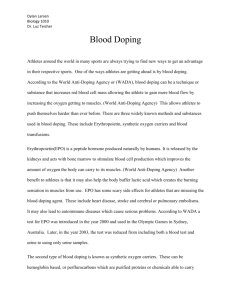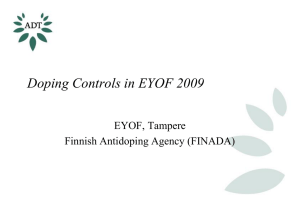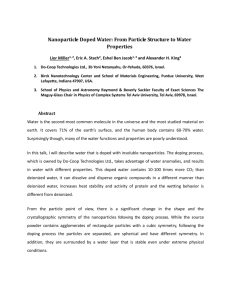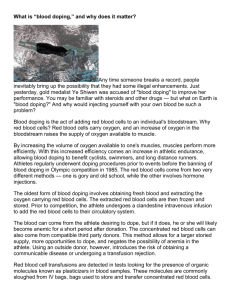BLood doping paper - Concordia University, Nebraska
advertisement
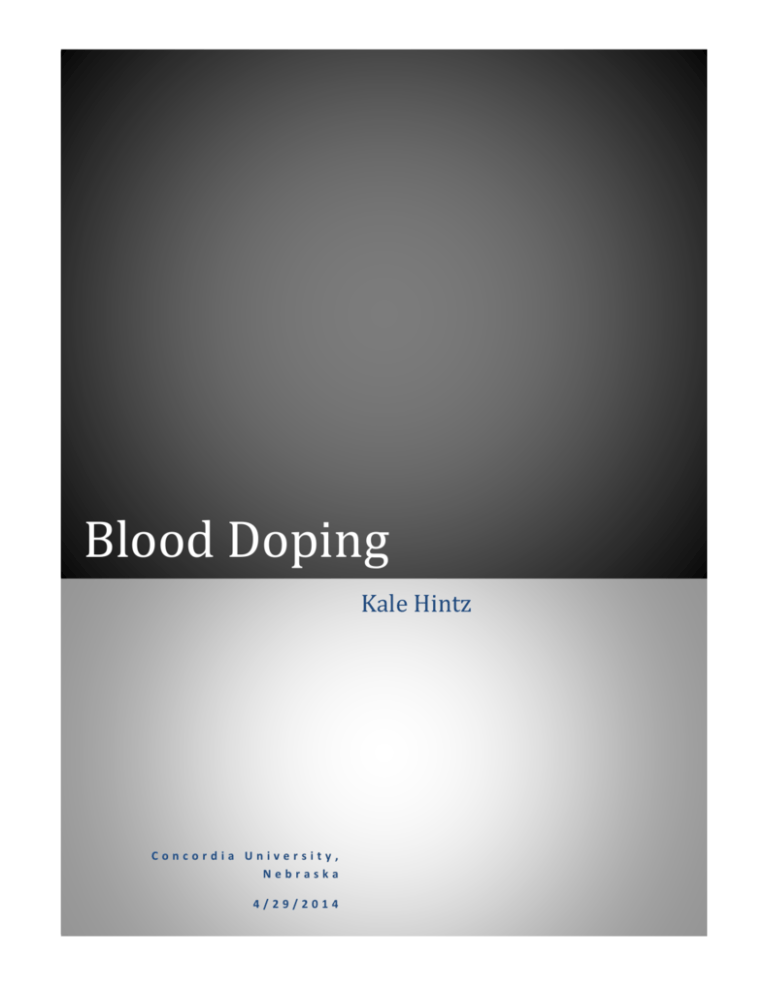
Blood Doping Kale Hintz Concordia University, Nebraska 4/29/2014 Kale Hintz Legal Aspects of Sport Blood Doping I have chosen to look into blood doping for my final research topic. Blood doping has taken the front seat in the sports world for performance enhancing drugs. News of blood doping is almost guaranteed to be found every summer and winter Olympic and World events. The reason that methods like blood doping and steroids are becoming so popular in sport is because of the rise in the level of play. In the far past an average athlete would likely not even make the team on many of today’s professional teams, with that in mind many athletes are looking for any way to get the upper hand on the opponents, even if that method is illegal and dangerous to their own health. To fully understand blood doping and why it has become a major topic in many sports today one must understand what blood doping is. Blood doping is, “the misuse of certain techniques and/or substances to increase one’s red blood cell mass, which allows the body to transport more oxygen to muscles and therefore increase stamina and performance” (WADA, 2011). Many sports like cycling and track that involve a large amount of endurance are typically where these techniques are used. Blood doping is to cycling and track as steroids are to baseball and it is becoming more and more aware of just how many athletes are willing to throw their morals and health to the side in pursuit of being number one. Through my research I have found that there are three categories of doping that are popular in today’s athletic competition. The three different types are: taking someone else’s blood and injecting it before competition, another way is to take your own blood out two weeks prior to competition and preserving it to be injected the day prior to competing , and the final is an injection of an artificial or synthetic oxygen carrier that acts as blood does. Each of these methods comes with their own risks and tests that are implemented to detect if an athlete is guilty of it. In everyday life blood transfusions and medications that improve oxygen absorption have tremendous success in improving patient’s conditions with serious life threating diseases like anemia. The difference between recreational use to improve athletic performance and medical use is that medical use return a patient to a normal level that they would be at without their medical condition. Recreational use is intended to give an athlete an advantage, by raising the volume of blood in the body to levels that are dangerous, and are likely to come with complications and can put athletes in life threating conditions, because these transfusions and dosages of medication are not supervised by a trained medical professional. As I said before there are three diferent types of blood doping but one is much more popular because of the medical advances in medications in the past 30 years. Recently the most popular, which was used in the Lance Armstrong scandal, is known as EPO (erythropoietin) which is a synthetic drug that carries oxygen as blood does. WADA (World Anti-Doping Agency) which is one of the leading forces against doping in sport explains that, “While proper use of EPO has an enormous therapeutic benefit in the treatment of anemia related to kidney disease, its misuse can lead to serious health risks for athletes who use this substance simply to gain a competitive edge” (WADA, 2011). It is well known that EPO as well as blood transfusions, by thickening the blood and increasing the volume of blood, leads to an increased risk of several deadly diseases, such as heart disease, stroke, and cerebral or pulmonary embolism. The misuse of recombinant human EPO may also lead to autoimmune diseases with serious health consequences. Blood doping’s potential increases substantially when the procedures are conducted by an untrained person in the legal use of these drugs and methods because the athletes may inject themselves with too much EPO, or inject themselves with contaminated or virus carrying blood. To prevent the misuse of blood transfusions the International Olympic Committee in corporation with the World Anti-Doping Agency created, “a test to test for blood transfusions (HBT) was implemented at the 2004 Summer Olympic Games in Athens” (IOC, 2008). To prevent the other methods of blood doping WADA is working at creating more advanced methods that can test for all types of doping with just one test. Recently, the poster child for blood doping is Lance Armstrong. Allegations began to surface about Armstrong’s use of performance enhancing drugs in the 1990’s and have continued to resurface well into the 2000’s, but because there was not sophisticated enough testing to verify all of the various types of doping he was able to slide under the radar and create a cycling powerhouse that was powered by a undetected doping market. Lance would have continued to run the program if 11 teammates would not have come forward to testify against Armstrong. The 11 members were, “ Frankie Andreu, Michael Barry, Tom Danielson, Tyler Hamilton, George Hincapie, Floyd Landis, Levi Leipheimer, Stephen Swart, Christian Vande Velde, Jonathan Vaughters and David Zabriskie(WADA, 2011). All of these members admitted to using EPO and other blood doping methods and maintaining a “code of silence” that was expected to be upheld in Armstrongs blood doping ring. After these members had come forward there was more than enough evidence, over 1000 pages of evidence documents to verify that there was an illegal blood program that was being run by Armstrong. Armstrong was given the same opportunity to come forward and be part of the solution, but he rejected it. Instead he exercised his legal right not to contest the evidence and knowingly accepted the imposition of a ban from recognized competition for life and disqualification of his competitive results from 1998 forward, this was including his record breaking 7 Tour de France winnings. By making this decision Armstrong was banned from professional cycling for life and is currently fighting on whether he should pay back prize money from all of the events that he had won in the allotted time period. “Two other members of the USPS Team, Dr. Michele Ferrari and Dr. Garcia del Moral, also received lifetime bans for perpetrating this doping conspiracy” (USADA, 2012). The sticky part about this investigation was that there was no hard evidence that convicted Armstrong of using these drugs. 500 tests were administered at random times in his career and none of them were tested positive for EPO or any other known illegal substance. “Because the USADA uses its own special arbitration procedures, many of which make a meaningful defense all but impossible, the protection afforded a defendant in a court of law simply aren’t there” (Butterworth, 2012). Overall in this trial it can be argued both ways that the processing of Armstrong was or was not carried out in the right manner. The second case that I have chosen to look into was the 2003 Russian female track team allegations of blood doping. This case involves seven Olympic female track athletes that competed for the Russian team at the Olympics and Worlds between 2000 and 2008. The IOC (International Olympic Committee) became suspicious of Russian urine sample between this time when the test samples that were sent in were suspiciously pure. As I said before blood doping isn’t a rarity in high endurance sports and some allegations surface every major event takes place like the Beijing Olympics, but the IOC took a very serious look into the Russian team because they suspected that the athletes were not the only ones in the wrong. The IOC released a statement in 2008 saying, “Russian tests are the most serious and have raised suspicions that some Russian officials were involved in helping the athletes to manipulate the samples by providing "clean" urine from a source, or knowing of the drug-taking activities” (Magnay, 2008). If this were the case it would be very hard to prove that the faulty samples had been used. The IOC implemented testing that would compare athlete’s tests to prior tests to decide whether the tests were truly theirs or if they had been replaced with a clean sample. The IOC released a statement 2004 stating, “ In order to further improve detection of abnormal blood profiles, WADA is leading the development of a strategy against doping in sport called the Athlete Passport, which is based on following athlete's biological variables over time” (IOC, 2008). The objective of this strategy, which will be added to other anti-doping strategies including "traditional" testing, is to detect abnormal variations of determined biological variables in order to better target testing and/or sanction those found with abnormal variations. Following the IOC’s investigation into the matter the seven athletes from the Russian team as well as three others from other team were not allowed to compete in the Olympics. A result of these trials the IOC has also improved the tests for blood doping and faulty test samples. When it comes to blood doping cases it is important to remember that there is a very wide range of drugs and techniques that fall under the umbrella term of “blood doping”. With someone storing their own blood and injecting it prior to competing the argument has been brought forward that it should not be considered to use your own blood to improve your athletic performance. Many athletes have tried to argue that it is known different than training at high elevation and competing at low elevation which improves oxygen transfer and use in the body. It can also be argued, like in the Armstrong case, that the USADA is able to operate in its own way of life and is able to punish those athletes that they feel are guilty as they see fit. Some have even gone as far as saying, “the allegations brought against Lance Armstrong by the USADA are not only vague enough that they would never hold up in any other court system but they also fail to show any specific evidence or list and individuals names that provided testimony in this case but when information is given the documentations says “multiple” individuals” (Butterworth, 2012). Overall I feel that blood doping is a dark shadow that will never go away in sports like cycling and track. I say this because the driving force behind athletes to be the best in the world far exceeds many athletes and officials, such as the Russians that tampered with test samples, morals of keeping the integrity of the sport. In addition to that, the fact that there is always new medications and techniques that are being created and researched to be able to bypass the current tests. I feel that it is going to be an ongoing battle between the anti-doping agencies and the doping organizations to see who can come up with the best technology. Works Cited Butterworth, T. (2012). The Kafkaesque Trial of Lance Armstrong: A Former Fedral Prosecutor On the US Anti-Doping Agency's Disregard For Due Process. Forbes. Magnay, J. (2008, August 2). Russia faces IOC action over drugs. Retrieved 2014, from theage.com.au: http://www.theage.com.au/news/latest-news/russia-faces-ioc-action-overdrugs/2008/08/01/1217097535147.html USADA. (2012). Statement From USADA CEO Travis T. Tygart Regarding The U.S. Postal Service Pro Cycling Team Doping Conspiracy. USADA. WADA. (2011, September). World Anti-Doping Agency play true. (W. 2014, Editor, & WADA, Lightmaker) Retrieved April 23, 2014, from www.wada-ama.org: http://www.wada-ama.org/en/resources/qand-a/blood-doping/
